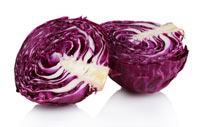
Yeah that’s right, there’s a way to indicate pH levels at home with the use of purple cabbage. First, let us briefly go over a little about acidic or alkaline properties. Liquids all around us have either of these properties. For example, apple juice, oranges, coffee and milk are all acidic liquids. Baking soda, soapy water and bleach are all alkaline liquids. Acids have a low pH with anything less than 7 and alkaline solutions have a high pH with anything above a 7. If the solution has an equal amount of acidic and alkaline molecules, pH is considered neutral. The pH of pure water is 7 and the normal range of surface water is between 6.5 and 8.5.
The cabbage contains a natural pH indicator that changes colors according to the acidity of the solution. In this experiment, we will use the juice from red cabbage as a pH indicator to test common household liquids and determine their pH levels. You will mix cabbage juice with different household liquids and see a color change produced by a pigment called flavin in red cabbage. Through this color change, you will be able to successfully identify the approximate pH of the household liquid. pH scale runs from 0.0 to 14.0 and is the measurement of a liquids level of acidity or alkalinity. Please refer to the chart below to match the pH numbers with the color change. Now, let us begin our experiment!
What you will need:
- A head of red cabbage
- Coffee Filters
- A funnel or coffee filter basket
- Knife
- Boiling Water
- Strainer
- Cups
- Solutions you wish to test (Baking soda, lemon juice, vinegar, etc.)
- Pitcher or Beaker
Procedure
- Chop the cabbage into small pieces until you have about 2 cups of chopped cabbage. Place the cabbage in a large beaker or pitcher and add boiling water till it covers the cabbage. Leave for about 10 minutes until purple color leaches out of the cabbage.
- Use your strainer or coffee filter to strain out the plant material to obtain the purple liquid by itself. Allow cabbage water to cool for 10 minutes.
- Pour the cabbage water into different cups depending on how many liquids you wish to test.
- Add the various household solutions to each cup and watch as the color will change according to its pH level.
- Refer to the chart below to indicate if the substance is an acid or a base.
- Record your results!
Notes:
- You can also make your own pH paper strips by soaking the coffee filter paper in cabbage water and then drying it. Once it dries you may cut the paper into several strips where you can drop several of the different solutions on the paper and watch the color change.
- This experiment will tell you whether the substance is acid or base, but not the exact pH value.
- This demo uses acids and bases.



